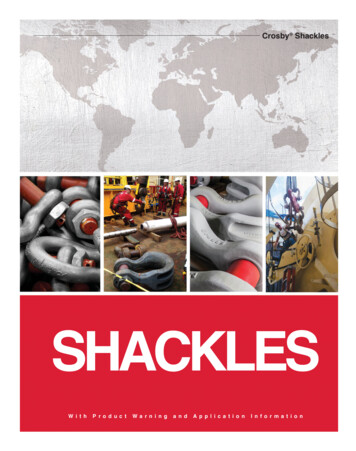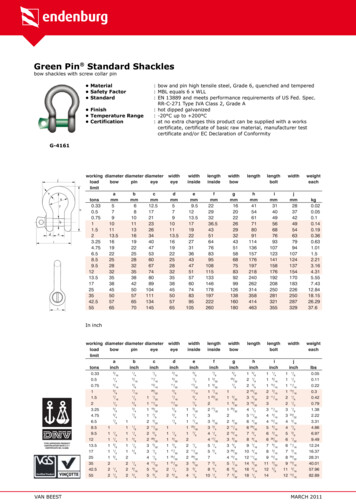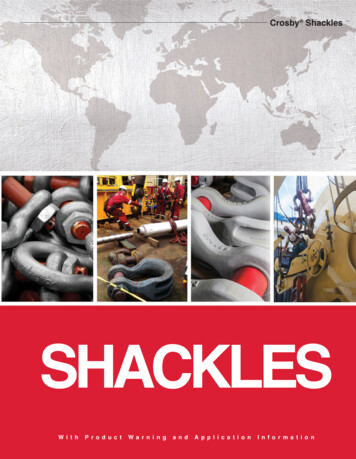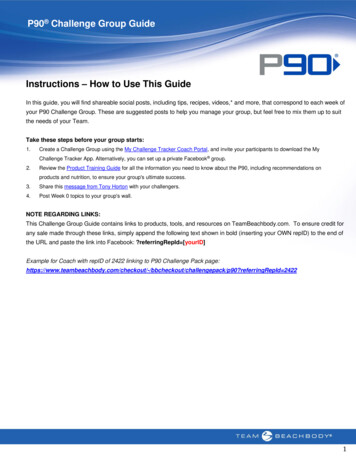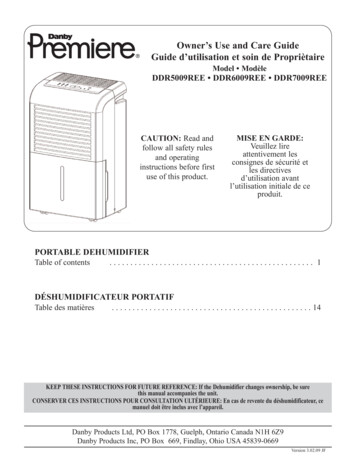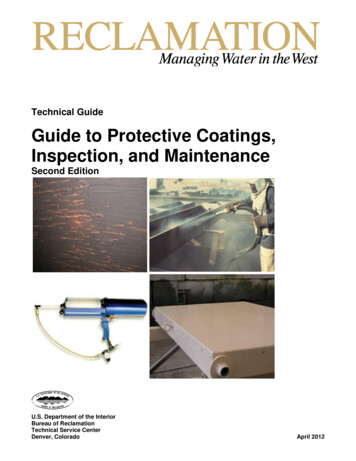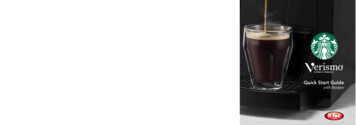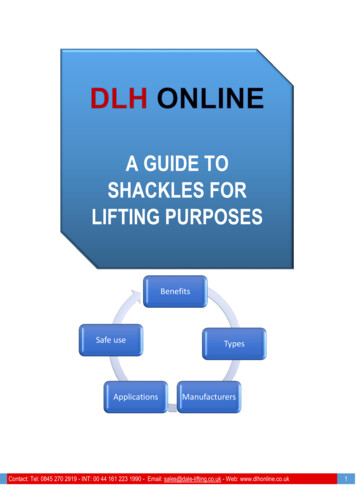
Transcription
A GUIDE TOSHACKLES FORLIFTING PURPOSESBenefitsSafe useApplicationsTypesManufacturersContact: Tel: 0845 270 2919 - INT: 00 44 161 223 1990 - Email: sales@dale-lifting.co.uk - Web: www.dlhonline.co.uk1
Table of kle TypesStandardsCertificationMarkings and Working load limitsBody shapesPin typesSpecial purpose shacklesInspectionStorage and handlingSafe useManufacturersMore information and Contact UsPageNo./link3345689101111121314Web Navigation Note:Links highlighted in blue are hyperlinks to relevant products and guideson our website DLH ONLINEContact: Tel: 0845 270 2919 - INT: 00 44 161 223 1990 - Email: sales@dale-lifting.co.uk - Web: www.dlhonline.co.uk2
1. OverviewShackles have been widely used in the lifting industry for decades.However, despite (or perhaps because of) the apparent simplicity andextensive use of these components, incorrect and poor specificationremains a problem. Indeed it is one of the ironies of the lifting industrythat it is not uncommon to see the safety of an operation involvingthousands of pounds-worth of crane being compromised by aninappropriate shackle costing next to nothing in comparison.Although there has been development of high performance shacklessuch as ROV for underwater off-shore use and Polar shackles forextreme temperatures. Our aim with this guide is to provideinformation on standard shackles for general lifting applications2. Shackle TypesAs far as shackles are concerned, there are three main types for thebuyer to choose from:Bow (or anchor) shackles, Dee (or chain) shackles and Grab shackleswith countersunk pinAll comprise a ‘U’ shaped body and a pin and they are sized by thediameter of the material in the body, not the pin which has a largerdiameter (Not to be confused with ‘Commercial’ mild steel shackles,where the body and pin have the same diameter and are not certifiedfor lifting purposes).Back to Contents pageContact: Tel: 0845 270 2919 - INT: 00 44 161 223 1990 - Email: sales@dale-lifting.co.uk - Web: www.dlhonline.co.uk3
3. StandardsNormally forged from steel and, size for size, alloy steel shackles havea higher safe working load (SWL) than those made in higher tensilesteels.Mild steel shackles are still manufactured for general engineeringpurposes but there is no longer a standard for such shackles for liftingpurposes.In theory, the metric British Standard BS 6994 (steel shackles for liftingand general engineering purposes – Grade M (4)) should have beenavailable since 1988. In practice very few shackles have ever beenmade to this standard and its imperial predecessor, BS 3032 (highertensile steel shackles) is still much more widely specified in the UK.Both standards have now been withdrawn by BSI although shackles toBS 3032 are still manufactured and the only current British Standard isBS 3551 (alloy steel shackles).US Federal Specifications, in the shape of RR-C-271, are increasinglypopular and there is also a harmonised European Standard for grade 6shackles, prEN 13889, Crosby shackles meet this standard.Crosby ScrewPin Bow(Anchor)ShackleCrosby Bolt andNut Pin Bow(Anchor)ShackleCrosby ScrewPin Dee (Chain)ShackleCrosby Bolt andNut Pin Dee(Chain) ShackleWhatever the individual preference, ensuring full compliance with therelevant standard should of course be a priority. The need to ensurefull compliance with the relevant standard cannot be over-emphasised.Contact: Tel: 0845 270 2919 - INT: 00 44 161 223 1990 - Email: sales@dale-lifting.co.uk - Web: www.dlhonline.co.uk4
Buyers should not only specify the size and type required, but also thestandard number; they must then check that the product supplied isstated to be in full compliance. Phrases such as “generally incompliance with” are meaningless and should set the alarm bellsringing.Back to Contents page4. CertificationAs standard lifting shackles supplied by us are accompanied with areport of thorough examination and or manufacturer declaration ofconformity.Upon request at time of order, all load rated shackles can be suppliedwith any of the following documents or certificates:- works certificate in accordance with EN 10204 - 2.1 or 2.2;- certificate of basic raw material in accordance with EN 10204 - 3.1.B;- manufacturer test certificate;- EC Declaration of Conformity in accordance with annex IIA of themachine directive 98/37/EC;- inspection certificate in accordance with EN 10204 - 3.1.B or 3.1.C;- proof load test certificate;- certificate with the actual breaking load experienced on testedsamples;- test report of Magnetic Particle Inspection (M.P.I.);- test report of Ultrasonic Inspection (U.S.).Additional costs will be charged.The test certificates can be supplied surveyed by all officialclassification societies, such as Lloyd’s, Det Norske Veritas, BritishStandards Bureau, American Bureau of Shipping, Germanischer Lloyd’sor any other officially certified inspection body.Back to Contents pageContact: Tel: 0845 270 2919 - INT: 00 44 161 223 1990 - Email: sales@dale-lifting.co.uk - Web: www.dlhonline.co.uk5
5. Working load limits and markingsShackles certified for lifting purposes are general stamped with theWLL, manufacturers mark and batch ID number.Crosby shackles are embossed with the WLL, Crosby name and batch IDnumber. Additionally all Crosby Shackles, with the exception of 2160,2169, 252 and 253 styles incorporate markings forged into the productthat address an easy to use QUIC-CHECK feature.Crosby shackles have angle indicators are forged into the shackle bowat 45 degree* angles from vertical.These are utilized on screw pin and bolt type shackles to quickly checkthe approximate angle of a two-leggedhitch, or quickly check the angle of asingle leg hitch when the shackle pin issecured and the pull of the load is offvertical (side loaded), thus requiring areduction in the working load limit ofthe shackle (See table 1).Side loaded rating reduction table for 3/16” - 3” (120 metric tons)Table 1Crosby Side Loading Reduction Chartfor ScrewPin Loadand Bolt Type Shackles Only Angleof Sidefrom Vertical InAdjusted Working Load LimitLine of Shackle0 - 5 In-Line*45 from In-Line*100% of Rated Working LoadLimit70% of Rated Working LoadLimit50% of Rated Working Load90 from In-Line*Limit In-Line load is appliedperpendicular to pin.* DO NOT SIDE LOAD SHACKLE PINFor shackles larger than 125 metric tons, where the angle of the sideload is greater than 5 degrees, contact Crosby Engineering.Contact: Tel: 0845 270 2919 - INT: 00 44 161 223 1990 - Email: sales@dale-lifting.co.uk - Web: www.dlhonline.co.uk6
In terms of correct specification of shackles, there are three maindecisions to be made: the SWL, the shape, and the pin type.The working load limit must be at least equal to the total load imposedupon the shackle.If the load on the pin is distributed over its length, or part of itslength, the load bearing capacity of the pin is effectively increased butthat of the body is not.It should be stressed that distributing the load right across the pin doesnot increase the strength of the shackle.Contact: Tel: 0845 270 2919 - INT: 00 44 161 223 1990 - Email: sales@dale-lifting.co.uk - Web: www.dlhonline.co.uk7
6. Body shapesLarge Bow (Anchor)shackleLarge Dee (Chain)shackleGrab ShackleSelection of the right body shape depends on the intended use. It isdesirable to use a shackle with as small a jaw opening as is consistentwith adequate articulation of the connection.Buyers were able to select from large and small Dee and bow shacklesto BS3032 standard, obviously providing a choice in terms of the size ofthe internal clearances.However, following the introduction of prEN 13889, which offer higherloading in a smaller size, the small Dee and Bow BS3032 shackles havebecome less cost effective and are now rarely available.Dee (chain) shackles are generally used to join two pieces of liftingequipment, while bow (anchor) shackles are typically employed wheremore than one attachment has to be made to the body.For example if joining two single leg slings andconnecting to the hook of a crane, or to allowfreedom of movement in the plane of the bow.The necessity for the eye of a shackle to passthrough another fitting may also have to beconsidered.Back to Contents pageContact: Tel: 0845 270 2919 - INT: 00 44 161 223 1990 - Email: sales@dale-lifting.co.uk - Web: www.dlhonline.co.uk8
7. Pin typesScrew PinBolt and Nut PinFor Dee and bow type shackles there are essentially only two types ofpin available: the screwed pin type and the nut and bolt type.The screwed pin issuitable for mostpurposes providedthere is little risk ofthe pin becomingunscrewed during thelifting operation. It hasthe advantage ofkeeping the shackle asa quick-to-assemble,two component item.The nut and bolt pin,together with a splitretaining pin, is a four component item. The advantage of the latter,however, is that the pin cannot unscrew in service.It is therefore more suitable in applications where there may bemovement which could cause the shackle to unscrew; where it remainsconnected for extensive periods; or in situations that do not allow theshackle to be seen easily and checked for security.Back to Contents pageContact: Tel: 0845 270 2919 - INT: 00 44 161 223 1990 - Email: sales@dale-lifting.co.uk - Web: www.dlhonline.co.uk9
8. Special purpose shacklesThe grab shackle is effectively a Dee shackle with ascrewed countersunk pin. As the name suggests, it isdesigned for use with grabs, where the shackle mustpass through a circular aperture of minimumdiameter.There is also available a Long Dee Piling Shackle with screwcollar pin which meets the performance requirements ofthe withdrawn standard BS 3032.As with all lifting equipment, it is vital that the buyer tells the supplierabout any particularly hazardous conditions or environmental issuesthat could compromise the long-term safety of the shackle.In particular, exposure to extreme temperature, chemical attack orother corrosive environments such as sea water should be mentioned.Corrosion resistant Stainless Steel lifting shackle to EN 10088 / 1.4404(Marine Grade 316L) are available:Back to Contents pageAISI 316 Stainlesssteel bow shacklebolt and nut pinAISI 316 StainlessAISI 316 Stainlesssteel Dee shackle bolt steel Dee shackleand nut pinscrew pinContact: Tel: 0845 270 2919 - INT: 00 44 161 223 1990 - Email: sales@dale-lifting.co.uk - Web: www.dlhonline.co.uk10
9. InspectionIn the UK, the Lifting Operations & Lifting Equipment Regulations(LOLER) make it clear that all shackles and indeed eyebolts (See ourinformation specifically on eyebolts) used for lifting purposes arelifting accessories.They should therefore be subject to a thorough examination by acompetent person at least every six months. Regardless of theprevailing legislation, the Lifting Equipment Engineers Association(LEEA) strongly recommends that this policy is adopted by all thosewith responsibility for ensuring the safe condition of lifting equipment.10. Handling and StorageWhen removing shackles from the lifting setup, it is good practice tore-assemble the shackle immediately. Leaving the pins loose candamage the threads. More importantly, as shackles are a forged itemthe pin and body are individually fettled to fit. It is not uncommon forshackles from the same batch to have varying mating alignment.On receiving a large batch of dis-similar shackles for inspection, wefound that the rigger had left the pin out of every single shackle and itbecame very evident that the finding the right body and pin match wasvirtually impossible. A costly error, as most of the shackles had to bereplaced.Back to Contents pageContact: Tel: 0845 270 2919 - INT: 00 44 161 223 1990 - Email: sales@dale-lifting.co.uk - Web: www.dlhonline.co.uk11
10. Safe UseAs with all lifting devices and operations, safety is of utmost importance.Here are some basic tips for ensuring optimum safety whilst usinga lifting shackle.ALWAYS:ern of shackle and pin for the application.e load acts through the centre line of the shackle usingspacers if necessary to meet this requirement.NEVER:pin with a bolt.unscrewthem.Instructions for the safe use and maintenance– PDF download: Safe use and maintenance of shacklesFor safe use instructions of other lifting equipment available from usClick HereContact: Tel: 0845 270 2919 - INT: 00 44 161 223 1990 - Email: sales@dale-lifting.co.uk - Web: www.dlhonline.co.uk12
ManufacturersThe Crosby Group has the most highly recognised brand names in thelifting industry. CLICK HEREThe Van Beest Company are a leading shackle manufacturerTheir Green Pin shackles are available in our Lifting Shacklesection on our website: CLICK HEREContact: Tel: 0845 270 2919 - INT: 00 44 161 223 1990 - Email: sales@dale-lifting.co.uk - Web: www.dlhonline.co.uk13
For more information please refer to the tables provided in our LiftingShackles web pages.10. Contact UsFor further advice on the above or for enquiries for lifting shacklesto your requirements, please contact our sales team on: 0161 2231990 or by email: sales@dale-lifting.co.ukDLH ONLINEDALELifting and Handling Specialists2 Kelbrook RoadManchesterM11 2QAUK. 0845 270 2919Intl. 00 44 161 230 1990fax. 0161 223 6767email sales@dale-lifting.co.ukWebsite www.dlhonline.co.ukVAT No. 145 5891 42Contact: Tel: 0845 270 2919 - INT: 00 44 161 223 1990 - Email: sales@dale-lifting.co.uk - Web: www.dlhonline.co.uk14
Crosby shackles have angle indicators are forged into the shackle bow at 45 degree* angles from vertical. These are utilized on screw pin and bolt type shackles to quickly check the approximate angle of a two-legged hitch, or quickly check the angle of a single leg hitch when the shackle pin is secured and the pull of the load is off vertical (side loaded), thus requiring a reduction in the .
